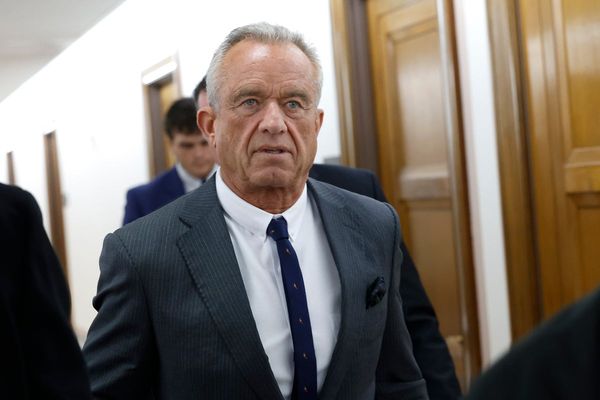
DESSAU-ROSSLAU, Germany—Earlier this summer, on the eve of regional elections in the eastern German state of Saxony-Anhalt, German politician Marco Wanderwitz was asked about the region’s strong support for the far-right Alternative for Germany (AfD) party.
Wanderwitz, the German government’s special commissioner for eastern Germany, attributed the AfD’s successes in the east to the region’s authoritarian past and said he believes only a small fraction of those voters are “potentially recoverable” for mainstream parties like his center-right Christian Democratic Union (CDU).
“We are dealing with people who are partially socialized by dictatorship in such a way that they have not reached democracy, even after 30 years,” Wanderwitz told the Frankfurter Allgemeine Zeitung.
Cue immediate outrage. Many in the region immediately blasted Wanderwitz’s comments as ill-informed and condescending—and saw them as only the latest dismissal of eastern German voters in a country where they often feel undervalued and misunderstood by the government or their counterparts in the west.
The resulting scandal underscored the outsized and often fraught role eastern Germany plays in Germany’s national political conversation. It’s been more than three decades since the fall of the Berlin Wall and German reunification. But the five eastern German states, often still referred to as the neue Bundesländer or “new states”—Brandenburg, Mecklenburg-Western Pomerania, Saxony, Saxony-Anhalt, and Thuringia—still vote very differently than their western counterparts, a fact that could impact September’s federal elections.
Those electoral differences have come into clearer focus in recent years with the rise of the grassroots anti-Islam PEGIDA movement in 2014 (which is based primarily in Saxony) and the last round of federal elections in 2017, when the east helped propel the AfD into the Bundestag for the first time. As a result, the region has frequently been portrayed as Germany’s electoral problem child.
“[In 1989, East Germans] demonstrated for free elections, for freedom of speech, for freedom of travel. … In other words, people in [East Germany] fought for their own right to democracy,” said Cerstin Gammelin, deputy Berlin bureau chief of the Süddeutsche Zeitung. “But once the wall fell, all of the West German structures were brought over, and suddenly, the eastern Germans were just the losers.”
“It’s such a paradox because they were actually so brave in bringing down the wall,” added Gammelin, who has written a forthcoming book on the role of the east in German politics. “But then, on the other side, they’re still always portrayed as the losers.”
Although the AfD has struggled to win over voters in western Germany, it has established itself as a significant force in eastern Germany: It’s the second strongest party in all five eastern states, sometimes winning upward of a quarter of the vote. What’s more, the party’s politicians in the east—like Thuringia’s Björn Höcke and the ex-party leader in Brandenburg, Andreas Kalbitz—have tended to be significantly more radical than those in the west.
By contrast, the Greens party—which consistently ranks second in national polling and is likely to be part of or even lead Germany’s next governing coalition—performs relatively poorly in the east, struggling to appeal to voters outside a handful of more left-leaning cities. The Left, a left-wing party born out of the Communist Party, is also significantly stronger in the east than the west, although it has lost steam in recent years due to the AfD’s rise.
Polling from Forsa in June underscored those differences: 26 percent of those surveyed in western Germany said they’d vote for the Greens compared with just 12 percent in eastern Germany. Meanwhile, the AfD is the second strongest party in the east with 21 percent of the vote—three times their support in the west, which is just 7 percent. (German Chancellor Angela Merkel’s Christian Democratic Union is the only party to get relatively similar support in both parts of the country: 25 percent in the west and 23 percent in the east.)
“Even 30 years after reunification, it’s still different,” said Peter Matuschek, chief political analyst at Forsa. “There are still two different electorates.”
This year’s three state-level elections shed light on how voting patterns differ—and on the extent to which the coronavirus pandemic may have even slightly sharpened those differences. Back in mid-March, two western German states went to the polls in regional elections: Baden-Württemberg in the south and Rhineland-Palatinate in the west.
The AfD sustained heavy losses in both, while the Greens gained in both. In Rhineland-Palatinate, the AfD dropped to just 8.3 percent, a 4.3 percent drop from 2016. The Greens, meanwhile, rose 4 points to 9.3 percent. In Baden-Württemberg, the Greens, which has led the government there since 2011, gained 2.3 points to win 32.6 percent; the AfD, by contrast, lost nearly a third of its electorate in the state (falling from 15.1 percent to just 9.7 percent).
Meanwhile, Saxony-Anhalt, which held elections on June 6, is friendly territory for the AfD. Even after the pandemic dimmed its support slightly, the far-right party won 20.8 percent in the state last month—a slight drop from its 2016 result but more than twice its national polling average.
What accounts for these differences? Although Wanderwitz might have attributed the eastern German political landscape to its voters’ experiences under communist rule, most people I’ve spoken with see it as a product of the events after the fall of the wall, not before.
“The higher-than-average success of the AfD in the ‘new states’ can almost entirely be explained by the experiences people had after 1990,” wrote sociologist Wolfgang Engler in Who We Are: The Experience of Being East German. “Not their supposedly obedience-oriented, leader-oriented [East German] habitus.”
There are plenty of reasons for eastern Germans to be frustrated. The region lags behind its western counterpart economically, with significantly lower wages and significantly higher unemployment. Much of its industry is owned by western Germans or foreign companies, and much of it has left in the years since the Berlin Wall fell. And the region is still hugely underrepresented in nearly all aspects of public life, from business boardrooms to the media to top jobs in politics.
Add to that the influx of refugees in 2015 and 2016, and it’s a potent mix for a party like the AfD. Even though very few refugees ended up in eastern Germany, Gammelin explained, “there was a great deal of worry that they would come and people would again lose the livelihoods they had managed to rebuild for themselves. And many of them voted for the AfD because they promised they wouldn’t let that happen.”
The AfD consciously plays with those resentments, making East German identity an implicit and explicit part of its pitch to voters in the region. Back in 2019, when three of the five eastern states held regional elections, AfD leaders ran on the slogan “Complete the Revolution” (“Vollende die Wende”), and campaign posters declared, “We Are the People,” a common refrain from the 1989 protests against the East German regime.
And at a campaign event in Dessau-Rosslau this spring, that strategy was again on display. Speaking to a hundred or so (mostly maskless) supporters on a main town square one Saturday afternoon, party leaders billed the AfD as the sole champion of individual rights and the successor to the 1989 protesters.
“You’re all helping write history,” Andreas Mrosek, who represents the AfD in Germany’s Bundestag, told the crowd. “Someday later, you can tell your children and grandchildren, ‘I helped usher in real political change.’” (The word he used for change, Wende, is the same one used to refer to the fall of the Berlin Wall and German reunification.)
Martin Reichert, another member of the Bundestag, spoke of a “political earthquake” back in 2016, when the party first entered the state parliament in Saxony-Anhalt. “That result gave many people in Germany courage and new strength,” he said. This year, with both state and federal elections, “it’s about nothing less than preserving our civil liberties and preserving democracy in Germany as we’ve known it these last years and decades.”
Antje Hermenau, a former member of the Bundestag for the Greens who quit her party in 2015, believes East-West differences in voting patterns have a clear explanation. “It’s very simple: eastern Germany is sober in the way it looks at reality, and the west is dreaming,” she said. (She includes her former party in those who aren’t grounded in reality.)
Hermenau has become something of an explainer for the rise of the AfD in eastern Germany: In her 2019 book, Views from the Center of Europe: How Saxony Sees the World, she argued eastern Germans remain more a part of eastern Europe than western Europe, and that affects their approach to politics. Eastern Germans went through a hard transition in the years following the fall of the Berlin Wall and are mostly looking to preserve the lives they built for themselves—and remain skeptical of those in power and the media.
The best proof that Wanderwitz’s comments about authoritarian experiences were off base, Hermenau added, is the AfD is strong among all age groups—including young people who weren’t even alive to see East Germany. In Saxony-Anhalt last month, the AfD won 17 percent of 18- to 24-year-olds, only slightly behind the CDU, and 28 percent among 25- to 34-year-olds, coming in first.
“You can’t just say that it’s only old people who haven’t fully accepted democracy; that’s nonsense,” she added. “Young people, who never lived in [East Germany] and weren’t socialized there also vote for the AfD.”
What’s more, voters in eastern Germany have less longstanding loyalty to any one particular party, which leads to volatility (and the opening that helped give the AfD its strong position there). “There’s no old party faithful—people change parties whenever they feel they need to,” Hermenau said. “Many voters see themselves as consumers: They vote tactically to support or avoid certain political developments.”
With Germany’s federal election on the horizon in September, the role of eastern Germany in determining the country’s political future is again in the headlines. Although the region comprises only a fraction of the German electorate—it’s home to just 12.5 million people of the country’s 83.2 people—it does have a disproportionate impact on the political conversation, both directly and indirectly.
With a tight race to determine which potential coalitions could be viable, a shift of a few percentage points for any single party could be a decisive factor. What’s more, the east’s impact doesn’t only show up at the ballot box: Last year’s fiasco over an informal cooperation with the AfD in Thuringia ultimately led to the resignation of Merkel’s hand-picked successor as the CDU leader, a potent example of the east’s role in determining the national conversation.
“In terms of sheer numbers, one could say there are fewer eligible voters in the east than in North Rhine-Westphalia, so in principle, they have no real impact,” Gammelin said. “But I don’t find that convincing. In this election, if the electoral constellations end up being tight, minority voting groups can be a deciding factor.”







